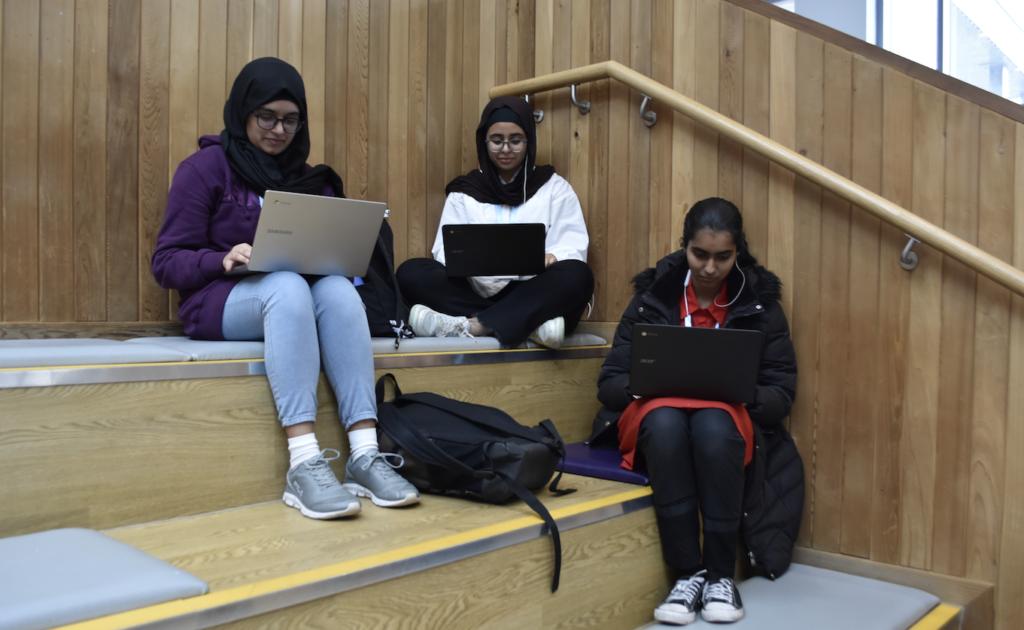GCSE Computer Science
GCSE Computer Science consists of two units 01 – Computer Systems and 02 – Computational Thinking, Algorithms and Programming.
Students have one hour a week on both units with separate computing teachers.
Year 10
Autumn Term
01: Computer systems
1.1 – Systems architecture
1.2 – Memory and storage
The purpose of the CPU.
Common CPU components and their function.
Von Neumann architecture.
How common characteristics of CPUs affect their performance.
The purpose and characteristics of embedded systems.
The need for primary storage
The need for secondary storage.
The units of data storage
02: Computational thinking, algorithms and programming
2.1 – Algorithms
2.2 – Programming fundamentals
The use of variables, constants, operators, inputs, outputs and assignments.
The use of the three basic programming constructs used to control the flow of a program.
The common arithmetic operators.
Principles of computational thinking.
Identify the inputs, processes, and outputs for a problem.
Create, interpret, correct, complete, and refine algorithms.
Standard searching algorithms.
Standard sorting algorithms
Spring Term
01: Computer systems
1.2 – Memory and storage
How to convert positive denary whole numbers to binary numbers (up to and including 8 bits) and vice versa
How to add two binary integers together (up to and including 8 bits) and explain overflow errors which may occur
How to convert positive denary whole numbers into 2-digit hexadecimal numbers and vice versa
How to convert binary integers to their hexadecimal equivalents and vice versa
Binary shifts
The use of binary codes to represent characters
How an image is represented as a series of pixels, represented in binary
How sound can be sampled and stored in digital form.
02: Computational thinking, algorithms and programming
2.4.1 Boolean logic
2.2 – Programming fundamentals
Principles of computational thinking.
Identify the inputs, processes, and outputs for a problem.
Create, interpret, correct, complete, and refine algorithms.
Simple logic diagrams using the operators AND, OR and NOT
Truth tables
Combining Boolean operators using AND, OR and NOT
Applying logical operators in truth tables to solve problems
Summer Term
01: Computer systems
1.2 – Memory and storage
1.4 – Network security
The need for compression.
Threats to computer systems and networks.
Identifying and preventing vulnerabilities
02: Computational thinking, algorithms and programming
2.3 – Producing robust programs
2.2.3 Additional programming techniques
Defensive design considerations.
Input validation.
The purpose of testing.
Types of testing.
Identify syntax and logic errors.
Selecting and using suitable test data.
The use of arrays (or equivalent) when solving problems
Year 11
Autumn Term
01: Computer systems
1.4 – Network security
1.3 – Computer networks, connections and protocols
Threats to computer systems and networks.
Identifying and preventing vulnerabilities.
Networks and topologies.
Wired and wireless networks, protocols and layers.
02: Computational thinking, algorithms and programming
2.1 – Algorithms
2.3 – Producing robust programs
Principles of computational thinking.
Identify the inputs, processes, and outputs for a problem.
Create, interpret, correct, complete, and refine algorithms
Defensive design considerations.
Input validation.
The purpose of testing.
Types of testing.
Identify syntax and logic errors.
Selecting and using suitable test data.
Spring Term
01: Computer systems
1.5 – Systems software
1.6 – Ethical, legal, cultural and environmental impacts of digital technology
Impacts of digital technology on wider society
Legislation relevant to Computer Science.
The purpose and functionality of operating systems.
The purpose and functionality of utility software.
02: Computational thinking, algorithms and programming
2.2 – Programming fundamentals
The use of basic string manipulation.
The use of basic file handling operations.
The use of SQL to search for data.
How to use sub programs.
Random number generation
Summer Term
Revision on both examination units
Assessment at Key stage 4
Internal
Low Stake assessments each week so the students can reflect on their prior learning.
End of topic assessments which have a section that reflect prior learning.
External
2 1.5 hrs examinations in Year 11
How can parents help support their child’s learning?
https://revisecs.computerscienceuk.com/free-resources/
https://www.youtube.com/channel/UC0HzEBLlJxlrwBAHJ5S9JQg
https://www.cgpbooks.co.uk/secondary-books/computer-science-ict
Enrichment opportunities
Trip to Bletchley Park and the National Museum of Computing
GCSE course/s (exam board and code)
OCR GCSE Computer Science J277
iMedia
The course consists of three units. Two Mandatory units – an examination at the end of Year 11 [R093] and an internally NEA RO94 completed in Year 10. They complete one optional unit in Year 11 and currently the plan is to deliver R097 – Interactive Digital Media
Year 10
Autumn Term
R094 – Visual identity and digital graphics
Develop visual identities for clients and use the concepts of graphic design to create original digital graphics to engage target audiences. Topics include:
– Develop visual identity
– Plan digital graphics for products
– Create visual identity and digital graphics
Spring Term
01: Computer systems
1.2 – Memory and storage
How to convert positive denary whole numbers to binary numbers (up to and including 8 bits) and vice versa
How to add two binary integers together (up to and including 8 bits) and explain overflow errors which may occur
How to convert positive denary whole numbers into 2-digit hexadecimal numbers and vice versa
How to convert binary integers to their hexadecimal equivalents and vice versa
Binary shifts
The use of binary codes to represent characters
How an image is represented as a series of pixels, represented in binary
How sound can be sampled and stored in digital form.
02: Computational thinking, algorithms and programming
2.1 – Algorithms
Principles of computational thinking.
Identify the inputs, processes, and outputs for a problem.
Create, interpret, correct, complete, and refine algorithms.
Standard searching algorithms.
Standard sorting algorithms.
Summer Term
01: Computer systems
1.2 – Memory and storage
1.4 – Network security
The need for compression.
Threats to computer systems and networks.
Identifying and preventing vulnerabilities
02: Computational thinking, algorithms and programming
2.3 – Producing robust programs
2.2.3 Additional programming techniques
Defensive design considerations.
Input validation.
The purpose of testing.
Types of testing.
Identify syntax and logic errors.
Selecting and using suitable test data.
The use of arrays (or equivalent) when solving problems
Year 11
Autumn Term
NEA – R097: Interactive digital media
Complete the externally set assignment brief.
and refine algorithms
Defensive design considerations.
Input validation.
The purpose of testing.
Types of testing.
Identify syntax and logic errors.
Selecting and using suitable test data.
Spring Term
Unit R093: Creative iMedia in the media industry
Examination Unit Learn about the media industry, digital media products, how they are planned, and the media codes which are used to convey meaning, create impact and engage audiences. Topics include:
– The media industry
– Factors influencing product design o Pre-production planning
– Distribution considerations
operations.
The use of SQL to search for data.
How to use sub programs.
Random number generation
Summer Term
Unit R093: Creative iMedia in the media industry
Examination Unit Learn about the media industry, digital media products, how they are planned, and the media codes which are used to convey meaning, create impact and engage audiences. Topics include:
– The media industry
– Factors influencing product design o Pre-production planning
– Distribution considerations
Assessment at Key stage 4
Internal
Feedback on SAMPLE NEAs to build up stills in prep for the NEA.
Low stake assessments when working on R093
External
NEA Assignment Briefs set by OCR which are internally marked and moderated by OCR
R093 examination in the summer of Year 11
How can parents help support their child’s learning?
https://sites.google.com/view/suefarrimondtutorials/image-editing-and-creation/photopea-basics
Enrichment opportunities
GCSE course/s (exam board and code)
Cambridge Nationals Creative iMedia Level ½ – J834
![]()



